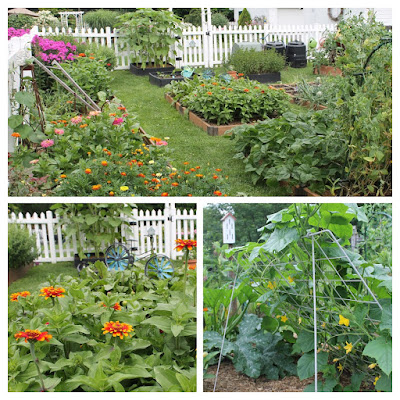 |
| Grow native plants such as butterfly weed in your sustainable garden. |
While researching sustainable gardening for my August newspaper article, I found a blog post I wrote on the subject in 2010. I think it is worth repeating. I've brought the information up to date and added some recent photographs. (I kept some of the original pics -- weren't Dude and the grandchildren cute back then? Well, they still are!)
What is Sustainable Gardening?
Most people are familiar with the term 'organic gardening' but what about 'sustainable gardening?' I like to think of practicing sustainability as 'adding to' the earth, rather than 'taking away' from it. This means my garden sustains itself as much as possible. Here are seven ways I practice sustainable gardening:
1. Making Compost
I have three compost bins, and some compost piles. My mini horse, Dude, would produce great compost I'm sure, but the only storage places are under the many, many walnut trees on the property. I'm afraid the juglone produced by the trees contaminates the compost -- as a result we lost vegetables two years in a row. So I stick to my compost bins that produce 'black gold' from garden cuttings, and the like.
 |
| Dude has other attributes such as being great fun for the grandchildren. |
 |
| I recently harvested compost from the bottom of the middle bin by raising the door at the bottom. |
Many of my gardens are lasagna gardens, made by layering newspaper and organic materials.
 |
| This is how the Serenity Garden began. |
2. Limiting Chemical Pesticides and Fertilizers
Using compost means I need less chemicals. I also use seaweed or kelp as a fertilizer to feed the earth and encourage a natural rate of plant growth. When making new beds, I cover weeds with cardboard or newspaper instead of applying herbicides. A chemical-free garden is a safe place for children. Without chemical pesticides and fertilizers you can still produce a bountiful harvest.
 |
| My grandson, now aged 14, still helps me in the garden. |
3. Increasing Water Retention
Mulching is a great way of helping the soil retain water. As those who follow my blog know, I use Canadian cedar mulch. I place soaker hoses under the mulch, but I mainly water by hand as I collect rainwater in barrels from gutters on the barn, tractor shed, and house roofs. We have a total of five water barrels.
 |
| Barrel collecting water from the house roof. |
 |
| Barrel collects water from the tractor shed |
4. Reducing the Lawn Area
Lawns use more water and fossil fuels to maintain than any other planting. I eliminated most of the lawn in the cottage garden since I wrote the original article. We still have far too much lawn area, but I’m working on it!
 |
| The pond and cottage garden occupy a former lawn area. |
5. Encouraging Pest Predators
Ladybugs are great predators for getting rid of aphids. Releasing ladybugs and praying mantis is a wonderful experience for children and a treat for your garden.
6. Removing Invasive Plants.
Multiflora rose is one of our biggest scourges. It is pretty in the spring, but kills all in it’s path. You have seen the following picture on my blog before:
 |
| There is a tree under there. |
When we removed the multiflora rose, we revealed a pear tree. H.H. made the most of the tree's naturally formed 'eyes' and 'mouth' and added a nose from a tractor part, a rake for a moustache, and a straw hat.
 |
| Our rakish pear tree |
7. Restoring Native Plant Communities.
Invasive species can upset the delicate balance of a local ecosystem and even make some native plants extinct, therefore it is important to restore native plant communities. Native plants generally require less fertilizer and other additives. They encourage native wildlife such as pollinators. Some of the many native plants that I've added to my gardens over the years include columbine Aquilegia canadensis, wild ginger Asarum canadense, butterfly weed Asclepias tuberosa (lead picture above), turtlehead Chelone 'Hot lips', Joe pye weed Eupatorium fistulosum, dwalf crested iris Iris cristata, liatris Liatris spicata, and beebalm Monarda didyma.
 |
| Liatris |
 |
| Turtlehead, bottom left, with buds about to burst into bloom today. |
 |
| Joe Pye Weed. This one is 'Little Joe' -- it doesn't grow so tall |
Practicing sustainable gardening is one of life’s challenges. It is a challenge that provides me with a great deal of satisfaction knowing that I am 'giving back to the earth.'
How do you practice sustainable gardening?
Pamela x
I love reading your comments. I hope you leave one so I’ll know you visited!
I look forward to visiting your blog in return.


















